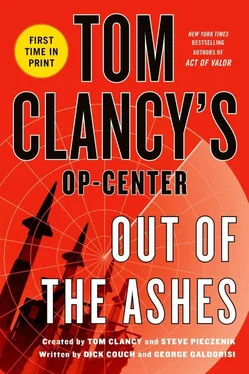Laurie had first entered Normandy ’s CDC on that day and had walked into a whole new world. Three weeks ago it was an unfamiliar and almost alien place. She was still battling seasickness then, as the Truman strike group had dashed across the Atlantic through the teeth of a howling winter storm. The storm had bounced Normandy around and caused substantial damage to many of the strike group’s ships, but now CDC was home. She felt empowered, but more than that, she felt needed.
Laurie had quickly learned CDC was the nerve center of the ship. It had taken her a while to absorb all she was looking at in the sea of symbols on the four forty-two-inch by forty-two-inch paired projection screens on CDC’s port-side bulkhead. She had also learned to make sense of the detailed information on the five ASTABs, automated status boards, on other bulkheads, as well as all the other screens displaying a wealth of information. She was no longer in information overload; she felt she was part of CDC.
The low, incessant hum of the air conditioning, the dim lighting that cast an eerie, almost sinister, glow throughout CDC, and the flickering green lights on the UYK-21 computers surrounding her had initially made Laurie feel like she was in another world. At first, her brain couldn’t process everything she was seeing; but now it almost felt like second nature each time she sat down at a watch station in CDC.
She recalled the first time she had seen this console and monitor.
“What’s this monitor for?” Laurie had asked, pointing at a small video monitor right above the radar console. “Oh, that’s our UAV monitor,” Brian Clark, Normandy ’s CDC officer, had replied.
Laurie was cheered. She had worked on unmanned aerial vehicle projects at National Reconnaissance Office as well as at the Center for Naval Analyses for years and knew quite a bit about them, but her knowledge was based on what she did in a laboratory environment at NRO and CNA. Seeing this actual monitor on a ship might help put her work in perspective.
“I’ll tell you, Laurie,” Mike Clark had continued, “those unmanned aerial vehicles were huge stars during Operations Enduring Freedom and Iraqi Freedom. Real vacuum cleaners bringing in tremendous amounts of information while flying in places we didn’t want to send manned aircraft.”
“And we’re using them now, right?”
“We are. Things haven’t really calmed down in the wake of the major Mideast uprisings in 2011, and the United States needs situational awareness of what’s going on here today more than we ever did. We use ’em all the time for ISR; that stands for intelligence, surveillance, and reconnaissance. We display the streaming video they send right here on this monitor, and on the Navy Tactical Data Consoles at other spots here in CDC. Between the UAV feed and our SPY radar we don’t miss much.”
“That’s great,” Laurie had replied, seeing the clear application of what she had worked on ashore. There, she didn’t really understand how these things were used operationally. It was all just numbers to her, but she was fascinated seeing the big picture in CDC.
Now, weeks later, sitting at this console was providing her with the job satisfaction she sought. It wasn’t her permanent station. Like the officers and crew who stood watch in CDC, she rotated between several watch stations, filling in where there was a need. She was an integral part of a team, something she hadn’t felt since she was working village stabilization operations in Afghanistan as a member of a Marine Corps Cultural Support Team.
Mike Clark walked up and broke her out of her musing. “Don’t forget to save any particularly interesting video and put it into the playback queue so we can look at it later.”
“Will do,” Laurie replied.
She thought of Charlie Bacon, the on-again, off-again boyfriend from her National Reconnaissance Office days she had told Sandee Barron about. She had worked with him on some of the early research on the technologies now used in the comms and sensor packages in these UAVs. Now some of that same technology was flying above the Gulf today. Laurie also thought about her growing friendship with Sandee. It had been a while since she had had a friend with whom she could share virtually everything.
However, this was no time for those thoughts or for her memories of Charlie and of a relationship they let fall apart for all the wrong reasons. Right now Laurie needed to just keep working. It cheered her when Mike Clark added, “You’re doing a hell of a job, Laurie. We’re lucky to have you here, and as things heat up, we’re going to need you even more.”
* * *
There was not much cheer, however, in the White House Situation Room, as a small group of the president’s advisors joined him in one of the Sit Room’s two secure conference rooms. The image of General Walt Albin, commander of the United States Central Command, or CENTCOM, covered the LCD screen at the front of the room.
“OK, General Albin, give us the lowdown,” the president said.
“Mr. President, as you know, things never really are completely quiet in this region,” Albin began. “The standoff between the Israelis and the Palestinians is as bad now as it’s ever been, especially after that series of suicide bombings last month. Iran is threatening Iraq again, as they fear the new democratic government we put in place there more than they ever feared Saddam.” Albin paused. “Mr. President, the level of tension has ticked up several notches over the past few weeks. As the new government in Syria tries to consolidate power, they are aligning even more closely with Iran as it jockeys for influence with the Saudis. As you know, Mr. President, Iran gives them massive military support, and, in turn, Syria aligns with them against Saudi Arabia—”
“And let me guess,” Midkiff interrupted, “because they’re pissed at the Saudis, lots of that splashes over on us!”
“Yes, sir,” Albin replied.
President Wyatt Midkiff had gone to the University of Florida on a Navy ROTC scholarship and had done a stint as a naval surface officer right after graduation. He respected his military advisors and didn’t like interrupting them, but his level of frustration with the continuing tensions in the Middle East was palpable.
Midkiff hadn’t been a key player in defense or foreign affairs during his sixteen years in the Senate and four years in the House, but he had absorbed something. Hell, even he saw these heightened tensions between Syria and Saudi Arabia coming back in 2011. Wasn’t anyone else smart enough to get it? Syrian President Bashar al-Assad was the most ruthless leader in suppressing his domestic democracy movement. Assad had slaughtered over one hundred thousand of his countrymen in the process. Even he eventually lost his battle for control and now the Alawite military controlled that country, and the Sunnis who had led the revolution were paying a terrible price.
The government in Syria, a cobbled-together alliance of Alawites, Shias, Druse, and even some Christians, didn’t really have complete control of the country, at least not yet. However, if that government had a single organizing impulse, it was enmity toward Saudi Arabia for killing and continuing to oppress its Shiite minority. The Saudis, who had no love for Syria in the first place, were now especially hostile toward the regime as it continued to oppress its Sunni majority.
Oh, and all that talk about the United States weaning itself off Mideast oil. Ha! From Midkiff’s perspective, that had gone down the tubes with the Deepwater Horizon disaster in 2010.
“Patricia, don’t we have any damn friends over there?” the president asked. He knew the answer to that question, but had to ask it.
Читать дальше












